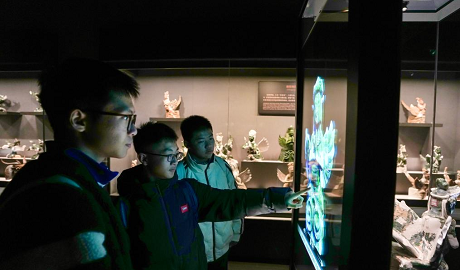

BEIJING, Nov. 16 (Xinhua) -- Chinese scientists have made a major breakthrough in lunar science by analyzing lunar samples brought back by the Chang'e-6 mission, providing a crucial scientific basis for lunar research, according to the China National Space Administration.
Researchers from Shandong University, the Institute of Geochemistry of the Chinese Academy of Sciences, and Yunnan University have, for the first time, discovered micron-sized hematite (α-Fe2O3) and maghemite (γ-Fe2O3) crystals formed by large impact events.
This discovery reveals a previously unknown oxidation reaction mechanism on the moon. It provides direct sample evidence supporting the origin of magnetic anomalies around the South Pole-Aitken (SPA) Basin.
Researchers identified hematite and maghemite in the lunar samples and confirmed the lattice structures and unique characteristics of primary lunar hematite grains using multiple techniques. These findings were published in the journal Science Advances.
Since the beginning of human lunar exploration, the moon has been considered a generally reduced body, with critical evidence of oxidation processes, particularly high-valence iron oxides like hematite, extremely scarce or absent.
The study proposes that hematite formation may be closely related to significant impact events in lunar history. The intermediate products of the reaction during impact events include magnetic magnetite and maghemite, which could be the mineral carriers responsible for the magnetic anomalies observed at the northern rim of the SPA Basin by previous remote sensing missions.
The research provides the first ground truth on strongly oxidized materials, such as hematite, on the lunar surface within an overall reduced context, shedding new light on the moon's redox conditions and the origin of its magnetic anomalies.
In 2024, Chang'e-6 made history by bringing 1,935.3 grams of lunar far-side samples back to Earth. These samples were collected from the SPA Basin, the largest, deepest and oldest basin on the moon.

Coffee plants enter harvest season in Baoshan, China's Yunnan

2025 China Golden Rooster and Hundred Flowers Film Festival concludes in Xiamen

Lakes nurture ecological wetland in Gobi Desert, NW China's Gansu


Students engage in cultural heritage education at Xixia Imperial Tombs archaeological site park
点击右上角![]() 微信好友
微信好友
 朋友圈
朋友圈

请使用浏览器分享功能进行分享
